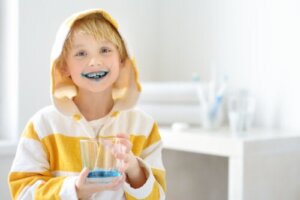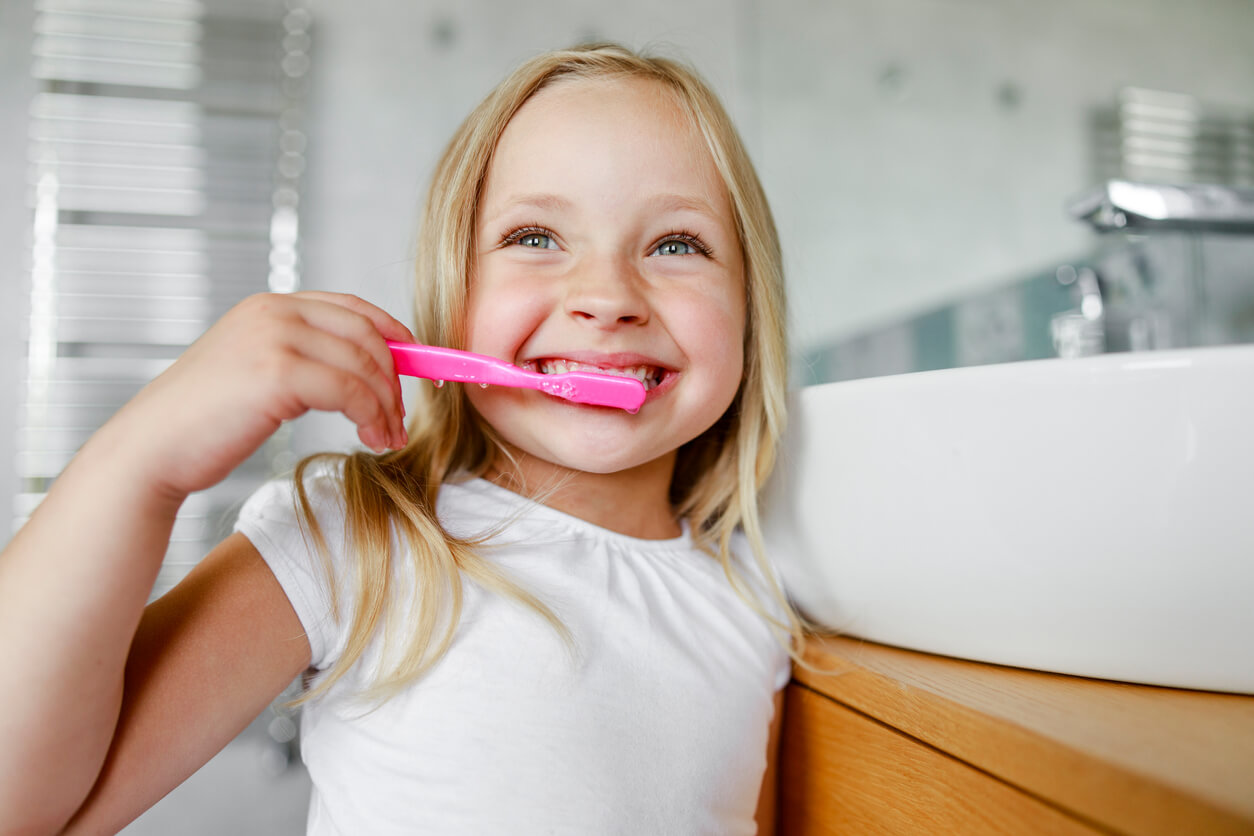Bacterial Plaque Disclosers in Children


Written and verified by the dentist Vanesa Evangelina Buffa
Bacterial plaque disclosers are products that help us to visualize the biofilm that accumulates on children’s teeth. These disclosers temporarily stain the debris in the mouth to better identify it. Keep reading to learn more.
Bacterial plaque, or biofilm, is a thin, translucent, sticky film formed by bacteria and sugars from the diet. It’s deposited and adheres to tooth surfaces and can be difficult to see with the naked eye. If it’s not removed by toothbrushing, it accumulates and acquires a yellowish-white color and a rough texture. It’s particularly visible at the junction of the tooth and gum and around orthodontic appliances, two areas that are difficult to clean.
When these residues remain in the mouth, they cause caries, gingivitis, and bad breath. Therefore, plaque disclosers are a great help for children to identify plaque and practice proper oral hygiene.
What are bacterial plaque disclosers for children?
As soon as plaque forms, it has a transparent appearance. This makes it difficult to see and gives the tooth a false appearance of being clean. Bacterial plaque disclosers, on the other hand, are substances that stain the biofilm and make it visible. This makes it easier to see the biofilm, makes it easier to remove, and improves brushing techniques.
The characteristics of plaque disclosers
Plaque disclosers used in children contain special dyes that dye the biofilm blue, red, pink, or purple and make it visible. To be used safely in the mouth, they must meet the following characteristics:
- Be easy to use.
- Not bothersome when in contact with the mouth.
- Have a pleasant taste.
- They must be biocompatible and soluble in water.
- They mustn’t irritate mucous membranes or cause allergies.
- Provide color contrast: The color intensity should change between new and old bacterial plaque.
- Be sufficiently long-lasting.
- Be easy to remove after use.

Presentations of plaque disclosers
When choosing plaque disclosers for your children, you can choose between different presentations. We’ll tell you which are the most commonly used so that you can choose the most appropriate one for your child.
Mouthwashes
Plaque disclosers in the form of mouthwashes are the easiest to use in children who can spit. They’re used in the same way as a mouthwash: The liquid is placed in the mouth and swished around for 30 seconds. Then, the liquid is thrown away and the child can observe the stained bacterial plaque in their mouth.
Chewable tablets
These are tablets that are chewed until they dissolve completely. Then, the saliva produced is circulated throughout the mouth, rinsed with water, and then the teeth are observed. These can be of a single color, which stains all the bacterial plaque red, or of double tone, which stains the old plaque blue and the newer plaque violet or red. However, while it may be fun for children to chew these tooth-painting tablets, they do last a long time in their mouths.
Disclosing liquid
This is another easy-to-use household method. It consists of placing 2 or 3 drops of the product in the mouth and circulating the saliva over all the teeth for one minute before rinsing in order to remove the excess. At this point, you’ll be able to see the stained plaque. In addition to staining the teeth, it also colors the gums and tongue, so it’s best to use it before the child goes to bed.
In this presentation, there’s also a photosensitive liquid that’s used in dental offices. It has the particularity of being visible when a special blue light is applied so that no traces are visible when leaving the office.
Disclosing gel
Gels are a type of plaque discloser for professional use. In this case, it’s placed on the teeth by a pediatric dentist in the dental office using small brushes or sponges. This procedure makes it possible to determine the risk of cavities, as the product stains the different forms of bacterial plaque in three different shades.

When to use bacterial plaque disclosers in children?
The purpose of bacterial plaque disclosers is to make visible this film of residue that’s deposited on children’s teeth and that isn’t visible to the naked eye. For example, it can be used before brushing teeth to show which areas to focus on. Disclosers are a useful resource for teaching children and practicing correct techniques. It can also be used after oral hygiene has been performed in the usual way. This helps to evaluate the effectiveness of the technique used and to detect which areas need more emphasis.
Plaque disclosers can also be a product that motivates children to care about their brushing. Seeing the residue deposited on their teeth helps them understand the importance of brushing an area that, at first glance, seems clean.
For children who wear braces, plaque disclosers are a great complement to oral hygiene. Visualizing the places where biofilm accumulates allows children to take care of hard-to-clean areas.
See what’s being cleaned
Plaque disclosers are a useful resource for practicing and improving oral hygiene techniques in children. Your pediatric dentist can advise you on how to use them on your child and at what times. Although there’s no need to use them every day, identifying the places where bacteria accumulate allows you to assess the need for this hygiene habit and to do it better and better. Taking care of oral health prevents many diseases, so it’s resorting to this resource that helps keep your children’s mouth healthy and radiant is worth it.
Bacterial plaque disclosers are products that help us to visualize the biofilm that accumulates on children’s teeth. These disclosers temporarily stain the debris in the mouth to better identify it. Keep reading to learn more.
Bacterial plaque, or biofilm, is a thin, translucent, sticky film formed by bacteria and sugars from the diet. It’s deposited and adheres to tooth surfaces and can be difficult to see with the naked eye. If it’s not removed by toothbrushing, it accumulates and acquires a yellowish-white color and a rough texture. It’s particularly visible at the junction of the tooth and gum and around orthodontic appliances, two areas that are difficult to clean.
When these residues remain in the mouth, they cause caries, gingivitis, and bad breath. Therefore, plaque disclosers are a great help for children to identify plaque and practice proper oral hygiene.
What are bacterial plaque disclosers for children?
As soon as plaque forms, it has a transparent appearance. This makes it difficult to see and gives the tooth a false appearance of being clean. Bacterial plaque disclosers, on the other hand, are substances that stain the biofilm and make it visible. This makes it easier to see the biofilm, makes it easier to remove, and improves brushing techniques.
The characteristics of plaque disclosers
Plaque disclosers used in children contain special dyes that dye the biofilm blue, red, pink, or purple and make it visible. To be used safely in the mouth, they must meet the following characteristics:
- Be easy to use.
- Not bothersome when in contact with the mouth.
- Have a pleasant taste.
- They must be biocompatible and soluble in water.
- They mustn’t irritate mucous membranes or cause allergies.
- Provide color contrast: The color intensity should change between new and old bacterial plaque.
- Be sufficiently long-lasting.
- Be easy to remove after use.

Presentations of plaque disclosers
When choosing plaque disclosers for your children, you can choose between different presentations. We’ll tell you which are the most commonly used so that you can choose the most appropriate one for your child.
Mouthwashes
Plaque disclosers in the form of mouthwashes are the easiest to use in children who can spit. They’re used in the same way as a mouthwash: The liquid is placed in the mouth and swished around for 30 seconds. Then, the liquid is thrown away and the child can observe the stained bacterial plaque in their mouth.
Chewable tablets
These are tablets that are chewed until they dissolve completely. Then, the saliva produced is circulated throughout the mouth, rinsed with water, and then the teeth are observed. These can be of a single color, which stains all the bacterial plaque red, or of double tone, which stains the old plaque blue and the newer plaque violet or red. However, while it may be fun for children to chew these tooth-painting tablets, they do last a long time in their mouths.
Disclosing liquid
This is another easy-to-use household method. It consists of placing 2 or 3 drops of the product in the mouth and circulating the saliva over all the teeth for one minute before rinsing in order to remove the excess. At this point, you’ll be able to see the stained plaque. In addition to staining the teeth, it also colors the gums and tongue, so it’s best to use it before the child goes to bed.
In this presentation, there’s also a photosensitive liquid that’s used in dental offices. It has the particularity of being visible when a special blue light is applied so that no traces are visible when leaving the office.
Disclosing gel
Gels are a type of plaque discloser for professional use. In this case, it’s placed on the teeth by a pediatric dentist in the dental office using small brushes or sponges. This procedure makes it possible to determine the risk of cavities, as the product stains the different forms of bacterial plaque in three different shades.

When to use bacterial plaque disclosers in children?
The purpose of bacterial plaque disclosers is to make visible this film of residue that’s deposited on children’s teeth and that isn’t visible to the naked eye. For example, it can be used before brushing teeth to show which areas to focus on. Disclosers are a useful resource for teaching children and practicing correct techniques. It can also be used after oral hygiene has been performed in the usual way. This helps to evaluate the effectiveness of the technique used and to detect which areas need more emphasis.
Plaque disclosers can also be a product that motivates children to care about their brushing. Seeing the residue deposited on their teeth helps them understand the importance of brushing an area that, at first glance, seems clean.
For children who wear braces, plaque disclosers are a great complement to oral hygiene. Visualizing the places where biofilm accumulates allows children to take care of hard-to-clean areas.
See what’s being cleaned
Plaque disclosers are a useful resource for practicing and improving oral hygiene techniques in children. Your pediatric dentist can advise you on how to use them on your child and at what times. Although there’s no need to use them every day, identifying the places where bacteria accumulate allows you to assess the need for this hygiene habit and to do it better and better. Taking care of oral health prevents many diseases, so it’s resorting to this resource that helps keep your children’s mouth healthy and radiant is worth it.
All cited sources were thoroughly reviewed by our team to ensure their quality, reliability, currency, and validity. The bibliography of this article was considered reliable and of academic or scientific accuracy.
- Changoluisa Venegas, A. D. (2022). Técnicas de cepillado dental en pre escolares, revisión de literatura entre 2010 al 2020.
- Acosta-Andrade, A., David-Solórzano, J., Pico-Sornoza, A., Sinchiguano-Quinto, K., & Zambrano-Torres, J. (2021). Correcto cepillado dental en niños: Artículo de revisión bibliográfica. Revista Científica Arbitrada en Investigaciones de la Salud GESTAR. ISSN: 2737-6273., 4(7), 2-22.
- Mensi, M., Scotti, E., Sordillo, A., Agosti, R., & Calza, S. (2020). Plaque disclosing agent as a guide for professional biofilm removal: A randomized controlled clinical trial. International journal of dental hygiene, 18(3), 285-294.
- Soto Echavarria, L. (2021). Influencia del uso del revelador de placa en el seguimiento de las instrucciones de higiene oral en pacientes de 6 a 15 años de edad: estudio caso control. Estudio piloto.
- Chiliquinga Macias, J. A. (2020). Efectividad del cepillado escolar supervisado en el control de placa bacteriana (Bachelor’s thesis, Universidad de Guayaquil. Facultad Piloto de Odontología).
- de Sousa, R. S. H. M. (2019). Comparação da eficácia do revelador de placa com método físico de descolamento.
This text is provided for informational purposes only and does not replace consultation with a professional. If in doubt, consult your specialist.








